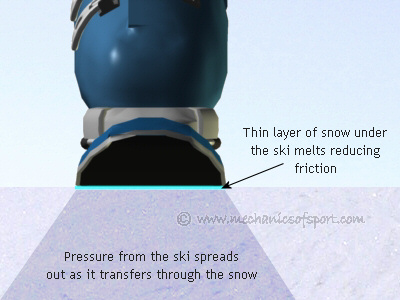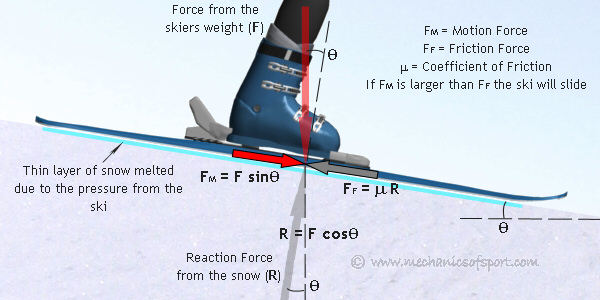Why Skis Slide
Why skis slide is often overlooked, this is because even though it is what the whole sport is based on, there are not so many ways to use it to your advantage within the technique side of skiing. It is never the less a good thing to know.

The reason that skis slide is that the temperature at which water freezes, changes with pressure. As pressure increases the temperature that water freezes at becomes lower. Put simply the pressure a ski puts on the snow, makes the snow directly underneath it melt. This creates a very thin layer of water between the skis and the snow, which largely reduces friction making the ski slide very easily. The more pressure applied the more snow under the ski will melt. The diagram illustrates the thin layer of snow that melts, and how the force from the ski spreads out as it goes through the snow.
Softer Snow
In softer snow, the snow needs to be compressed before there is enough force to support the ski, this can use a lot of energy in the compression, and is a large reason as to why you can not glide as far or fast in powder or softer conditions. This is very noticeable when skiing off-piste.
Refreezing
The thin layer of snow that is melted under the ski refreezes as soon as it is not in contact with the ski any more, as the extra pressure has gone. When it refreezes, it does not turn back to snow, as the snowcrystals have melted, it turns to ice. It is only a very thin layer of the snow that melts, so you wouldn't normally realise that there is a very thin layer of ice there. However, if there is a slope that has had lots of people going down it, without being prepared again by a piste machine, it can have a noticeable icy layer on top. This will happen more or less depending on the general snow conditions and temperature, etc.
Sliding on a Slope
To explain quickly why we slide when we are on a slope, this is because the reaction force from the snow (R), is at a different angle to the force from our weight. This means there is a component of the force created by our weight in the direction of the slope (FM) as shown in the diagram below. The friction force (FF) is calculated by multiplying the coefficient of friction (μ) by the reaction force from the snow (R). Because the pressure of the ski has made a thin layer of snow melt, μ is very low, and in most conditions the slope angle (θ) will not need to be very big before FM is larger than FF and the skis start to slide.

Wet Snow
If the snow is very wet (generally at times in the spring), the skis will not slide as well. This is because then there is so much water under the ski that it leaves no room for air to get under the ski so that it can release itself. This creates a vacuum under the ski as it tries to move, which sucks the ski down, and stops the ski from sliding anywhere near as easily as in good snow conditions.
Wax
Wax is applied to base of skis to further reduce friction and make the skis slide more easily. For more information on ski waxes please read the wax section of the ski construction page.
For the sections explaining resistance and edge effects, friction between the ski and the snow has been ignored as it is negligible compared to the other forces that are acting.
On to the Direction of Least Resistance section.